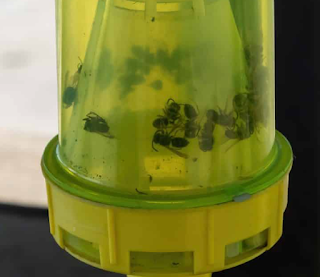Safely Managing Yellow Jackets: A Guide for Environmental Enthusiasts
Yellow jackets, armed with a sharp stinger and known for their aggression, can be a cause of concern. Before embarking on their removal, it's crucial to properly identify them, especially with the ongoing threats to honeybee populations worldwide. This guide provides not only identification tips but also safe and natural ways to deal with yellow jackets.
Identifying Yellow Jackets:
- Distinguish yellow jackets from honeybees by examining their segmented body. Unlike honeybees with a connected thorax and abdomen, yellow jackets have a hairless thorax and a distinct waist.
- Note their stinging behavior; honeybees have a barbed stinger that remains in the victim, leading to the bee's death, while yellow jackets can sting multiple times.
Safety First:
- Yellow jacket stings can be painful and, in some cases, lead to anaphylactic shock. It's essential to cover as much skin as possible during removal to minimize the risk.
- Wear long sleeves, gloves, thick pants, and secure boots to reduce the chances of being stung. Although there is always a risk, these precautions significantly lower the likelihood of stings.
Removal Methods:
'Trapped & Zapped!' – Using Conventional Traps:
- Identify the reason for yellow jackets' presence, often protein sources.
- Set up conventional traps with protein bait, ensuring that once inside, yellow jackets cannot escape.
- Exercise caution while handling traps, considering the potential danger of interacting with yellow jackets.
'Bowls Are Full!' – Placing Bowls Over the Nest Entrances:
- Suitable for ground nests, cover entrances with bowls to trap yellow jackets inside.
- Ensure tight sealing against the ground and sufficient weight to prevent movement.
- This method is advised in areas with no small children or animals.
'A Hint of Mint!' – Use All Natural Peppermint Oil:
- Mix a few drops of pure peppermint oil, dish soap, and warm water in a spray bottle.
- Spray the mixture around and inside nest openings during the night when yellow jackets are least active.
- Consistent spraying over several days is crucial for effectiveness.
Conclusion: Dealing with yellow jackets requires caution, awareness, and a commitment to environmental responsibility. By following these methods, you can safely address yellow jacket presence while minimizing potential risks.
FAQs:
Why is proper identification of yellow jackets crucial before removal? Proper identification ensures you are addressing the correct species, especially with the ongoing threats to honeybee populations.
What safety precautions are recommended during yellow jacket removal? Cover as much skin as possible, wear protective clothing, and exercise extreme caution due to the potential danger of yellow jacket stings.
How do conventional traps work, and what should be considered when using them? Conventional traps use protein bait to lure yellow jackets in, preventing their escape once inside. Caution is advised while handling traps.
When is the 'Bowls Are Full!' method recommended, and what precautions should be taken? This method is suitable for ground nests, and precautions include tight sealing and sufficient weight to prevent bowl movement. It's advised in areas without small children or animals.
How does peppermint oil work, and why is consistent spraying necessary? Peppermint oil is a natural deterrent for yellow jackets. Consistent spraying over several days is necessary to effectively persuade yellow jackets to leave.
Unlock the secrets to safely managing yellow jackets with our expert guide! Discover identification tips, crucial safety precautions, and three natural removal methods. Safeguard your surroundings while contributing to environmental responsibility.
#YellowJacketRemoval, #SafePestControl, #EnvironmentalAwareness, #NaturalSolutions, #BeekeepingTips

